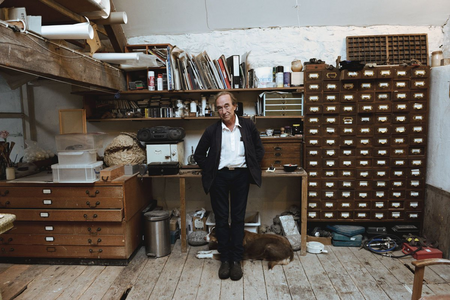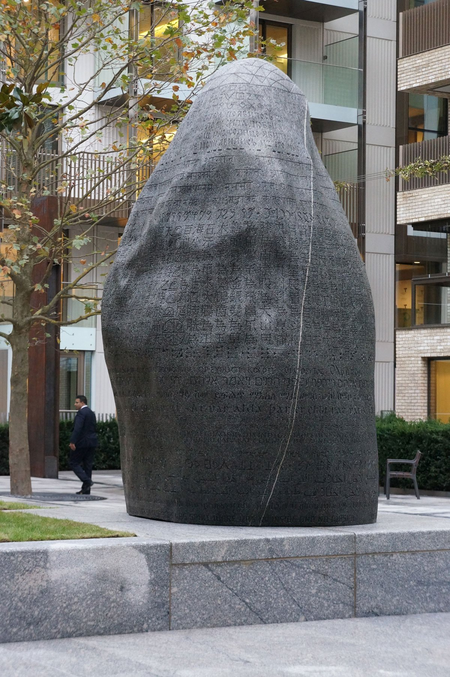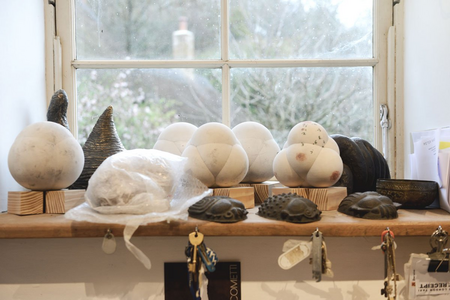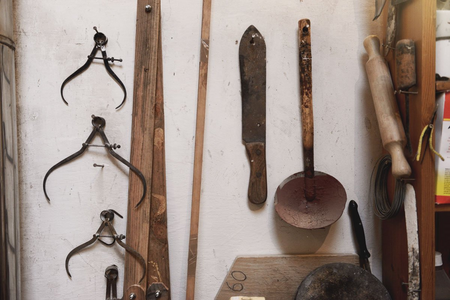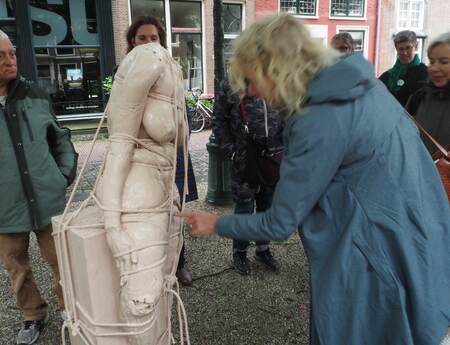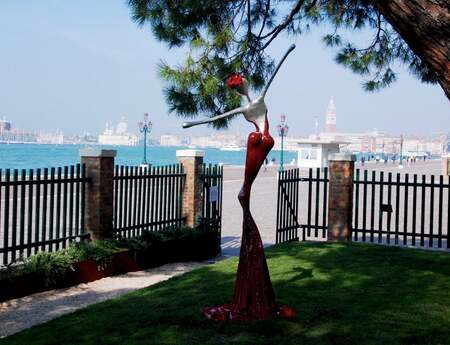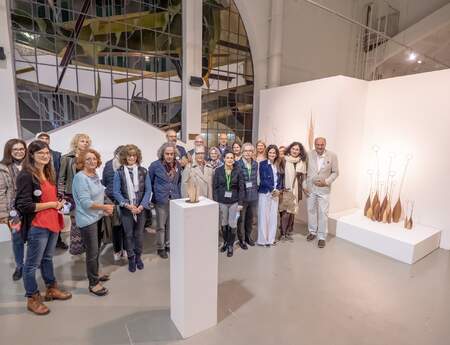Interview with Peter Randall-Page
This interview with artist Peter Randall-Page was conducted by Daniel Lingham, editor and founder of Sculpturevox for the first issue of the magazine.
The article published here is a shortened version of the conversation with the sculpture network-member.
About Peter
Peter Randall-Page born 1954 graduated from Bath Academy of Art 1977. He has gained an international reputation through his sculpture, drawings and prints with workin public and private collections throughout the world. His sculptures can be found in many urban and rural locations throughout the UK and is in the permanent collections of the Tate Gallery and the British Museum amongst others.
In June 2015 Peter was elected as a Royal Academician in the category of sculpture and holds four Honorary Doctorate titles including three Doctorate of Letters.
From the beginning
Peter Randall-Page works with the very essence of time and form and pays homage to the monolithic results created by fundamental forces of nature over the huge expanse of our earth’s existence. He’s a significant creative force at work and many a young British sculptor makes the mental if not physical pilgrimage to his doorstep. As a sculptor I have admired his work for many years and as a stone carver I have been in awe of the scale, precision and creative manifestations. I’m a little biased and Peter would brush away notions of grandeur in favour of talking about why he really does what he does and why he’s only now really getting started.
‘The material is incidental’ he might like to say because deep beneath the creative process is a need to communicate something raw, intuitive and universally common – what it is to be human. There is no better example of this than his latest monumental sculpture at Fitzroy Place London. ‘The One and The Many’ a 3.5 meter high, 25 tonne granite boulder incorporating writing systems from the earliest cuneiform script to modern languages. The marks convey creation stories from cultures around the world.
I wanted to trace some of Peter’s time, so we go back to a beginning…
You became assistant to Barry Flanagan on leaving art college. How did that opportunity come about and how formative an experience was it?
My meeting with Barry Flanagan was very quirky. A friend of mine who sold him a second hand car mentioned to Barry that he had a good friend studying sculpture at Bath Academy of Art and was just about to finish. We met up in London and got on very well. Barry came down to see my degree show which was on at that time in Bath and was very complimentary about it. Subsequently I ended up getting to know Barry very well and he asked me to work with him. I didn’t realise, because I was so naive, what an extraordinary opportunity it was. He took me round London, introduced me to lots of galleries lots of people in the art world and lied through his teeth telling them he had bought the whole of my degree show, which was completely untrue, he hadn’t bought anything. He flagged up my work to many prominent galleries and then I ended up working with him. I had been working with stone a little bit, although I worked with lots of different materials when I was a student. Barry had just been to Italy and he’d seen how they do scaling from maquettes using triangulation but they were very secretive about it. They wouldn’t actually teach anybody how to do this method of enlarging. These days you can go and sign up for a course in Carrara and they teach you how to do it. At that time it was a trade secret so Barry tasked me to find out how you scale up from a small model to something big. After researching at the British Library I found nothing about the process and ended up inventing my own method which was rather clumsy, but it did work. It wasn’t the method they use in Italy, the ancient method of triangulation which subsequently I worked it out for my own purposes. We worked together, he would make little clay and wax models and I would scale them up using my own homespun method. I was living in London after leaving Bath and it was a very formative period for me. He was great company a really good person to spend time with.
We worked together for about a year. but in the end it was getting to the point where I was making work that felt more like my things than his. But even though I had to stop working with Barry we carried on being friends until his death.
What was the next step after Barry, did you know what you had to do next?
You never know what you have to do next. I needed to earn money to survive and I got a job working at Wells Cathedral in Somerset in conservation and restoration work on the front of the cathedral. That was a wonderful opportunity. I have been blessed with lot of wonderful opportunities. As well as conserving and restoring the 13th century statuary on the west front I was re-carving some of the ornamental work such as finials, capitals and foliage carving. It was bizarre in a way that I had been at college in Bath and nobody had ever mentioned medieval sculpture. It was a magnificent and wonderful sculptural tradition and strangely in the 1970s nobody was talking about it.I had only really been aware of modernism and a general sense of art history so this was a great opportunity to go up to the top of the scaffolding and look at these wonderful things at close quarters.
Why is stone the predominant material in your work?
I think there’s a number of reasons for that. On a material level it’s quintessentially stuff – it’s what the earth is made of. Particularly igneous rock which is just dumb matter, something that’s been molten and congealed. There’s something rather fundamental about that which appeals to me. In terms of working processes it’s already something. When you get a lump of stone, whatever shape it is, it’s already a thing. It’s a matter of modifying that thing to make it more meaningful or more important than it is just as a result of lots of chance events over a geological timescale. That’s important to me on a very practical level, the fact that you have got a thing that you are then modifying is the opposite to a blank sheet of paper or a squidgy bag of clay. I’m modifying something which already has a presence.

Situated at Fitzroy Place, London.
Photograph by Thomas Randall-Page
Your work is about order in nature, it’s a geometry of natural form and as such seems to be equally at home in a natural landscape as it is in a gallery space. Do you think that’s because you are tapping into something fundamental and universal or because of a quality in the material?
I hope it’s because I am tapping into something universal but I think actually what my work’s about, although I use this relationship between order and randomness in my work a lot, is the human condition. The nature of human consciousness is what I really want it to be about. It’s a way of exploring what is significant to us, what shapes and patterns and forms mean something to us, and why they mean something to us. That ultimately is to do with evolutionary psychology in our dealing with order and randomness in nature.
Time and space and mathematical ordering can be seen in your pieces. Do you think that the scale of your work is important in that conceptual aspect?
The scale is important in relation to the human body. Sculpture is the least abstract of the arts in a sense other arts forms like literature and music operate in a temporal level. They are there when you are experiencing them…then they are gone. Painting, photography, things which have a frame round them create an abstract conceptual space that may only be alluding to three dimensions or an arrangement of shapes on an abstract level on a plane within a frame. Sculpture is right there with us in our time and space. It’s in our world, and not abstract at all. You can stub your toe on it quite easily. It’s a way in which we are dealing with the idea of what it’s like to inhabit a human body, a temporal form, not translated or edited but what it’s like to ‘be’ in a physical world. That’s why it appeals me. The scale that I like to work on is either a scale of something you can hold in your hand or the size of the human body. Of course when you’re making things in relation to landscape and architecture the other element is the scale of that environment.
In parallel to your choice of material, in how I perceive you, is that in terms of your career you are carving a groove in the sculptural artistic landscape. After a time you can look back and see how far you have come as an artist. Did you ever imagine you would get this far and do perceive yourself as an important sculptural artist?
No I don’t. I have certainly felt that I wanted to move the argument forward in terms of sculpture. I have always wanted to be involved in the ongoing understanding of why making objects and showing them to other people is still a relevant way of communicating in an age of the most incredibly sophisticated technological communications. I am on the edge of the art world. I have always felt that the artworld has never known quite what to make of me. I felt I have had to justify what I am doing because I work with stuff and I am interested in what one can convey by making objects and physicality. I was very dyslexic as a child so understanding the world in terms of reading was not available to me. My understanding of the world has been through a long informal study of phenomena and playfulness. Just making stuff and seeing what happens.
I am interested in working in ways where you are making it up as you go along. There are certain ways of working which are conducive to that. Carving is one where making a decision, acting on it and then making another one happens without you really noticing. You are chipping away, you’ve got rhythm going, you’re carving with a hammer and chisel and you’re making decisions without realising you are making decisions. There’s an easy flow in that sort of working process. The same applies with drawing, painting and working with clay.I suppose lots of choices about how I work are trying to find ways in which I can be unselfconscious. It’s where you start to find out the most interesting things, discovering things you didn’t know before.
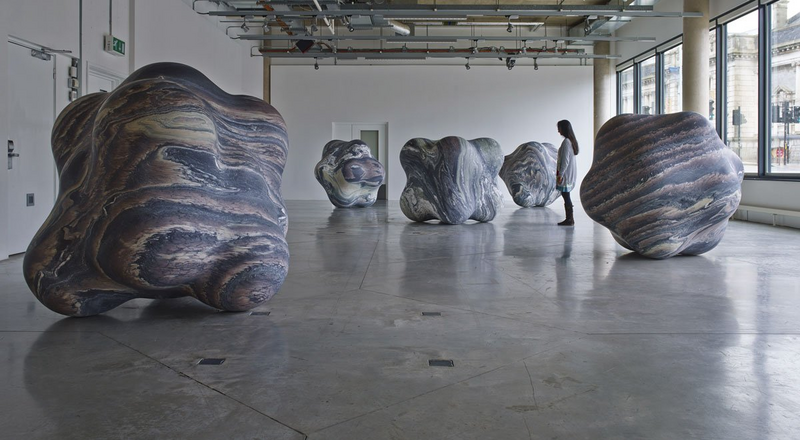
Because of the scale and presumably the rate of your output you do need some assistance in producing the work. Is there a quality you look for in your assistants and do you have an apprenticeship period?
They have all turned up in a very ad hoc way. I hadn’t really ever advertised for a particular sort of person. There have been lots of people who have come through the studio, like Mat Chivers for example, who was an ambitious young artist. For someone like Mat he has gone on to develop his own vocabulary and career. We have people in the office which is important to keep the whole thing running. I have worked with David for over 30 years now. He originally trained as a sculptor at Wimbledon Art College but I think he decide a long time ago that he didn’t want to make sculpture for himself. We kind of understand our roles. Speaking from my point of view, many of the people I work with wouldn’t particularly want the responsibility of having an idea, making it and seeing whether anybody’s interested in it. There’s a lot of problem solving, a lot of aesthetic decisions which I must make myself. We talk all the time. I feel that we have a good working relationship and have worked with these people for a long time. Of course, I couldn’t have made remotely the number of things that I have just on my own.
For example, when i make a maquette and translate it into something larger in stone. In that process I am completely in control of making the model and I also understand the method by which we will then enlarge it. There’s usually a lot of material that needs to be removed to get to that point and that’s done with measurements so no aesthetic decision to be made. I then take over and finish the work myself. I try and make sure that I am not asking them to make aesthetic decisions on my behalf.
Surface texture plays a key role in a lot of your work and it would seem that you are not making the stone be something else but using it as a canvas for applied meaning, a bit like a meta object. Many of your pieces remain recognizable boulders.
Most of the ways of working that I choose involve some element of chance or a given random element which is why I often choose these eroded boulders and on the other hand some sort of ordering principle. The point of choosing those ways of working is to create a space between order and chaos where I can just play unselfconsciously but within certain rules. The interesting thing about freedom is that ironically to have artistic freedom requires constraints. In order to play you need to create a finite playground. Whether working with stone, clay or paper involves trying to choose ways which enable me to create that set of rules in which I can be free.
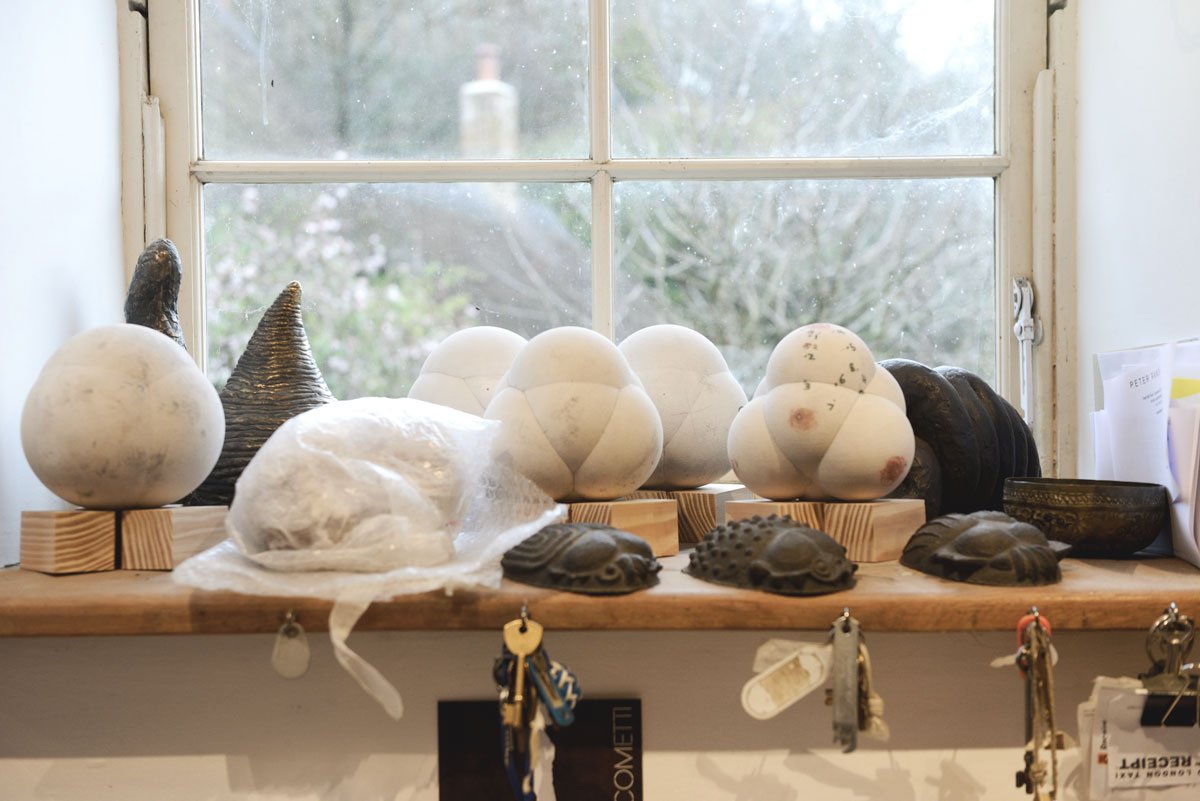
Photograph by Anne Purkiss
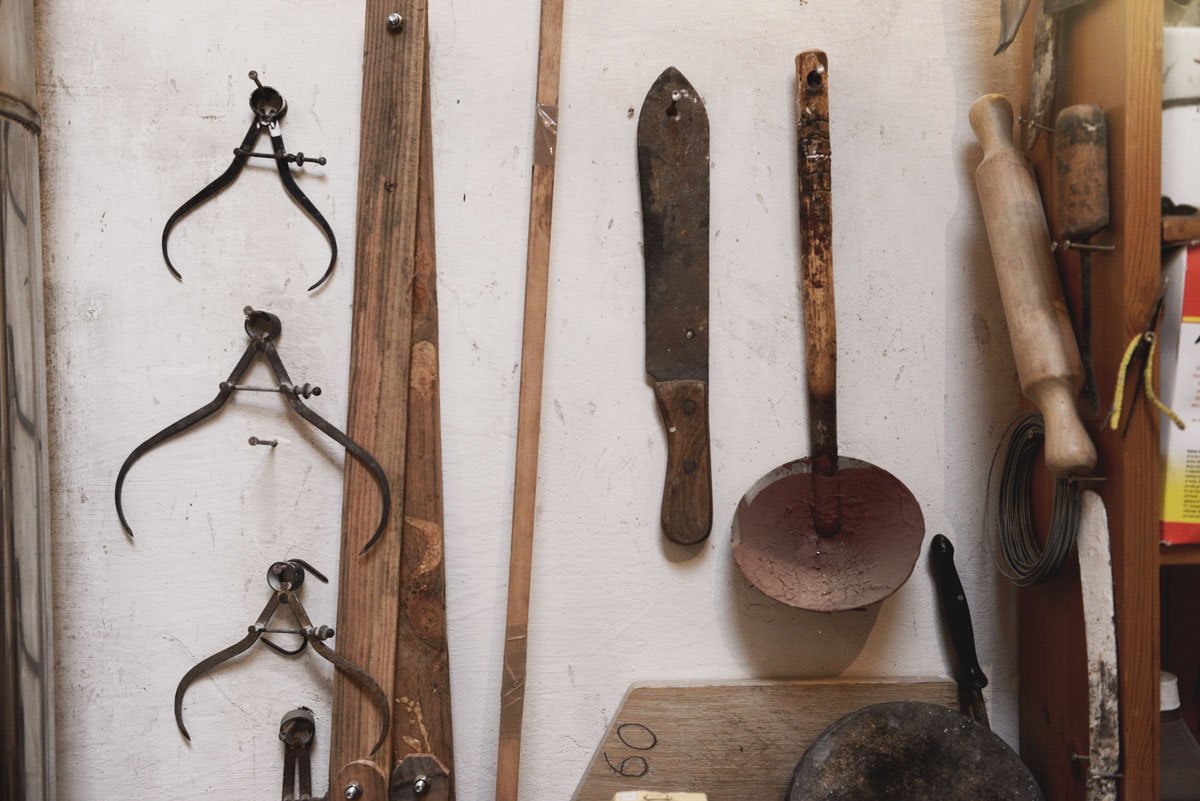
Photograph by Anne Purkiss
Are you looking for order and meaning on a personal level that’s reflected in your work, perhaps solving your own riddle?
I don’t think so. I don’t think there is any meaning basically. The magic of what human beings do is to find meaning. We create meaning, we bring meaning into a meaningless world. That’s the magic. That’s the bit I am interested in. I am certainly not trying to solve anything. If anything I am enjoying the riddle. If I was pushed to say what I want my sculptures or the things I make to be it would be just objects of contemplation and meditation. I am not trying to find any answers.
Possibly provoking more questions than answering?
On the level that I am trying to work there aren’t any answers. On the one hand there is what might be meaningful to us because we are these clever monkeys that have evolved in particular ways and bizarrely we’ve ended up with this rather over inflated brain that is able to contemplate things on an abstract level. What is really wondrous is that the evolutionary process that created us has produced something that can actually ponder itself, can look at the whole thing and find it beautiful or frightening or moving.
What about the notions that it’s not necessarily an answer to a big question but almost like a spiritual response. You’re work has a zen quality to it in terms of the way you use patterns.
I am not religious although I read a lot of religious texts because I think it tells us a lot about the human condition. I would like to think that the things I do are something that makes one think slightly differently about the extraordinary position of our human existence.
In 2016 Peter Randall-Page has been involved in a project at Dulwich College in London with Grimshaw Architects where he’s been developing an algorithmic system which encompasses the whole of the facade of this new building. The artist has no plan for retirement, he feels like he’s just getting started.
Interview by Daniel Lingham
Main photograph and studio photography by Anne Purkiss
Sculpture network already reported about the magazine Sculpturevox in the magazine. You can find the article here.
The unshortened interview can be found here.
Title: Peter Randall-Page at his studio 2015. Photograph by Anne Purkiss
